Samuel Pickworth Woodward, 1821-1865
by Brian Stevenson
last updated May, 2020
Microscope slides with handwritten, dated labels and the initials “S.P.W.” are seen with some frequency (Figure 1). Investigations into those initials, dates, locations of collection, and subject matter revealed that the maker was Samuel P. Woodward, a noted English biologist and geologist. Woodward worked for the British Museum and the Geological Society, was a Professor of Natural History and Geology at the Royal Agricultural College, assisted with the work on many important scientists (including Charles Lyell, James Tennant, John E. Gray, and Richard Owen), and wrote an authoritative, multi-volume work on mollusks.
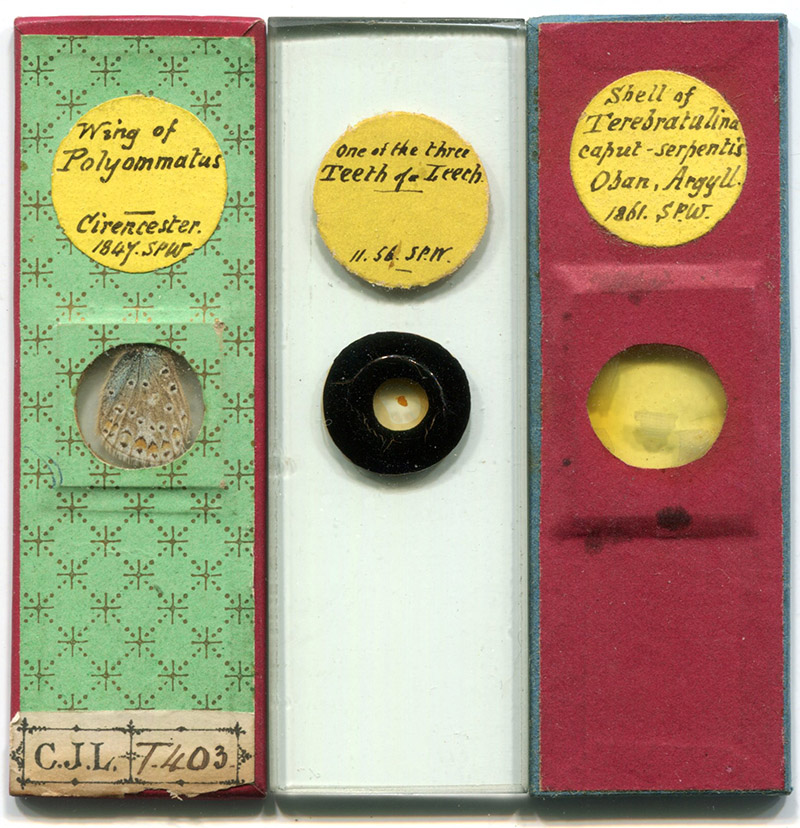
Figure 1.
Microscope slides by S.P. Woodward. Left: wing of a Polyommatus icarus butterfly (common blue), prepared in 1847, when Woodward was a professor at the Royal Agricultural College in Cirencester. Center: tooth of leech, prepared in November, 1856. Right, piece of shell from Terebratulina caput-serpentis (a bivalve mollusk), collected in Oban, Scotland, and mounted in 1861. Woodward covered this species in the second volume of his “Manual of the Mollusca” (1854). The identity of “C.J.L.”, who put a label on the butterfly wing slide, has not yet been confirmed.
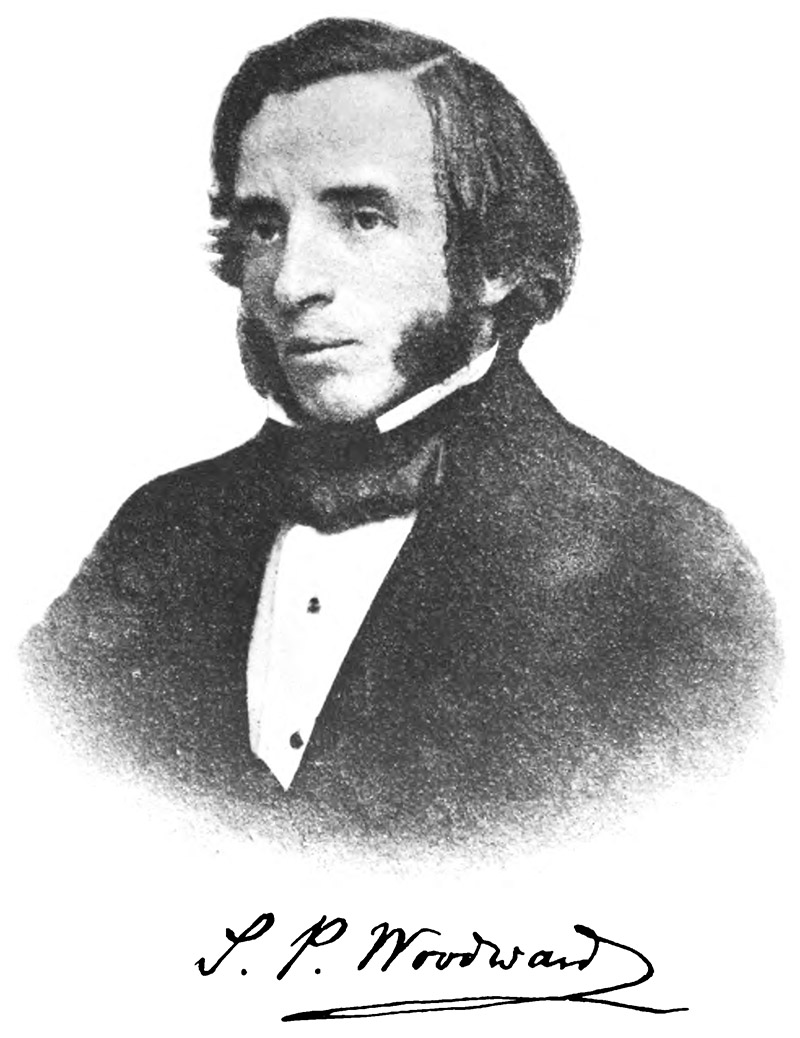
Figure 2.
Samuel P. Woodward, from a photograph taken in 1856. The image was printed alongside his biography in “The Transactions of the Norfolk and Norwich Naturalists' Society”, 1882.
Samuel Pickworth Woodward was born in Norwich, Norfolk, on September 17, 1821. His father, also named Samuel, was a bank clerk and avid naturalist. The father was well-known in the area for his studies of Norfolk geology, biology, and antiquities. In 1831, he published a report on having identified a sawfly, Trichiosoma lucorum, in the area. The specimens had been caught by young Samuel. The young boy also provided a drawing of the insect, which was reproduced along with his father’s report (Figure 3).
In 1835, when not yet 14 years old, Samuel was sent to the home of Dawson Turner in Yarmouth. Dawson (1775-1858) was a banker by trade, and botanist by hobby. Samuel’s job that year was to help Turner collect plants. He returned the next year, after school ended, to help arrange Turner’s plant collection. He wrote to his parents, “My work this morning consisted in carrying the plants from the Ante-library to the Attic, up two long flights of stairs, more than twenty times, with as many as I could possibly carry, Mr. T. laughing all the time in a manner peculiar to himself. Mr. T.'s collection consists of almost all the British flowering plants, a vast number of foreign plants, mosses, fungi, &c, &c., named and arranged according to the old system. These I shall have to clean, re-name and arrange according to the present systems. Besides these, Mr. T. has a great quantity of unarranged plants (many hundreds) which I shall have also to clean, name, fasten on paper and arrange; they are mostly in parcels just as they were sent from all the great botanists who lived twenty or thirty years ago, some of the plants have been in the papers they are now in more than forty years, and the worms have eaten them through and through, but they are very valuable nevertheless!"
Samuel’s son, Horace, later wrote, “In this employment he made great progress with his botanical knowledge, and for some years afterwards the study of plants became the pastime of his leisure hours. In the course of time he formed a large and valuable herbarium himself, chiefly made between the years 1835-50, and which was ultimately purchased for the Royal Agricultural College at Cirencester”.
In 1837, Samuel took work at a school in Fakenham, Norfolk, and with a lawyer in Norwich.
His father died in 1838, when Samuel was only 17.
Samuel found work in London, arranging and cataloguing the library of Hudson Gurney (1775-1864), a politician, poet, and collector of antiquities. Through Gurney’s assistance, Woodward obtained a position in the library of the British Museum, in May, 1838.
Woodward evidently did good work, for in 1839 he was appointed sub-curator to the Geological Society of London.
Again from Samuel’s son, “While his attention was confined to geological subjects during the day, he gave up much of his spare time to botany. In 1839, he was elected a member of the Botanical Society of London”. In 1841, Woodward became an Associate of the Linnean Society.
Associated with his job at the Geological Society, Woodward assisted Roderick Murchison (1792-1871) with production of the 1843 Geological Map of England and Wales (Figure 5).
In 1845, Woodward was appointed Professor of Geology and Natural History in the Royal Agricultural College, which had just been established in Cirencester. He was expected to “teach the rudiments of those sciences, and to draw attention to the various insects, animals, plants, or minerals, with which the farmer in this country is most concerned. … Portions of the above course of instruction were given in the field”. It was during his time in Cirencester that Woodward prepared the butterfly wing slide that is shown in Figures 1 and 8.
Also during 1845, Samuel married Elizabeth Teulon. Quoting their son, “during the course of the next fifteen years he became possessed of eight ‘hostages to fortune’, two of whom, however, did not survive a very tender age”.
During July, 1846, Woodward joined “a few Naturalists met at the ‘Black Horse’ on Birdlip Hill, and in the course of a walk through Witcorabe Woods, to the Roman Villa, and Cooper's Hill, (came to appreciate) how much enjoyment and instruction might be gained by a simple ramble through beautiful scenery, in company with several men who are all more or less skilled; but at least, all interested in that glorious study of nature". They then established the Cotteswold Naturalists' Field Club, of which Woodward remained a member for many years after leaving the area (Figure 5).
The following summer, the administration of the College evaluated their finances, and decided to eliminate Woodward’s professorship. He left Cirencester in December, 1847.
Moving back to London, Woodward picked up temporary work with the Botanical Society and with James Tennant (1808-1881) “whose large collection of fossils he assisted in naming and arranging”.
In July, 1848, Woodward secured an appointment as “First-class Assistant” in the Department of Geology and Mineralogy of the British Museum. He remained in that position for the remainder of his brief life.
While working for the Geological Society during the early 1840s, Woodward had served under Edward Forbes (1815-1854), who had a particular interests in mollusks. Their friendship inspired Woodward to investigate that topic. As a result, he published A Manual of the Mollusca in three parts, in 1851, 1854, and 1856 (Figure 5). This series of books was very well received, and was acclaimed by Charles Darwin and many other scientists.
During 1853, Woodward helped John Edward Gray (1800-1875) with his Catalogue of the Mollusca in the Collection of the British Museum. The preface noted, “Mr. S.P. Woodward has kindly assisted in the preparation of the Catalogue, especially as regards the fossil species, and in drawing the illustrations, which have been engraved by Miss Ann Waterhouse of the School of Design’ (Figure 6).
In 1854, Woodward was elected as a Fellow of the Geological Society of London. He was awarded the proceeds of the Wollaston Donation Fund in 1854 and 1857, in recognition of his paleontological work. In 1859, Woodward was elected to Geological Society’s Council, a position which he held for the remainder of his life.
Woodward assisted Richard Owen (1804-1892) with production of the latter man’s Palaeontology (Figure 7). The acknowledgements included, "for the drawings and most of the facts or their verification, relating to invertebrate fossils, the writer is indebted to his experienced colleague in charge of that department of the British Museum, Mr. S.P. Woodward, F.G.S."
Honors for Woodward’s work followed, including appointment as a Foreign Associate of the Zoologico-Botanical Society of Vienna in 1862, and an Honorary Ph.D. from the University of Göttingen in 1864.
During the 1860s, he also served as an “Examiner in Natural Sciences” of military cadets in Sandhurst, Woolwich, Chelsea, and Portsmouth, and as “Examiner in Geology and Palaeontology” at the University of London.
From his early twenties, Samuel Woodward suffered from “asthma”. This may have been more than we currently recognize as asthma, and might have been an infection such as tuberculosis, especially considering the blood in his sputum when he died. An obituary noted that Woodward’s symptoms “became so distressing as to awaken the sympathies of all, and caused many to marvel at the energy he displayed in research and conversation during intervals of release from pain”. Samuel’s son wrote, “In the early part of 1865 his asthmatic attacks had become much more troublesome and frequent, and his strength thereby was greatly reduced. In the spring-time he kept at home on sick-leave, and Professor Owen wrote to him (May 25th) strongly recommending him to put all thoughts aside of returning to work at the British Museum, until he had completely recovered his bronchial troubles: adding, ‘you are too precious to us to be risking anything by prematurely returning to this atmosphere’. Later on he went to Herne Bay in the hopes of recruiting his health and strength. But, as on many a previous occasion, his zeal and interest led him to undertake expeditions to which his physical strength was unequal, and the rupture of an artery in the lungs, occasioned by overexertion at this Kentish watering-place, was the immediate cause of his passing away on the 11th July, when he was not quite forty four years of age”.
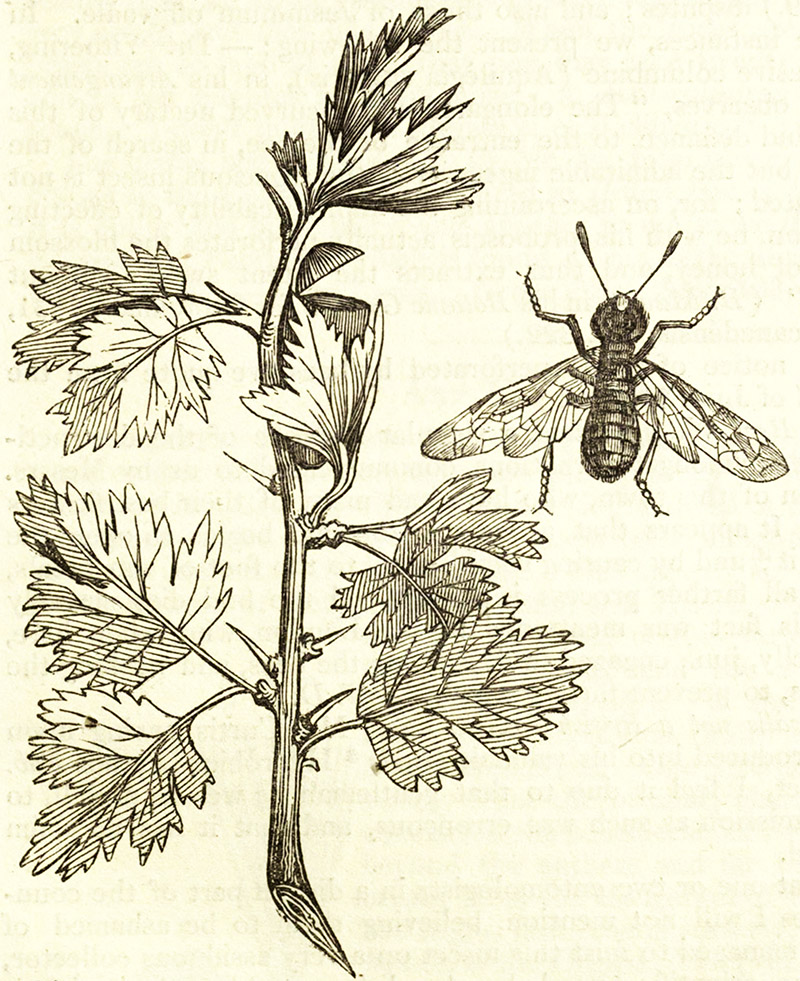
Figure 3.
1831 lithograph of Trichiosoma lucorum, from a drawing by 9 1/2 year-old Samuel Woodward. From his father’s report in “The Magazine of Natural History”.
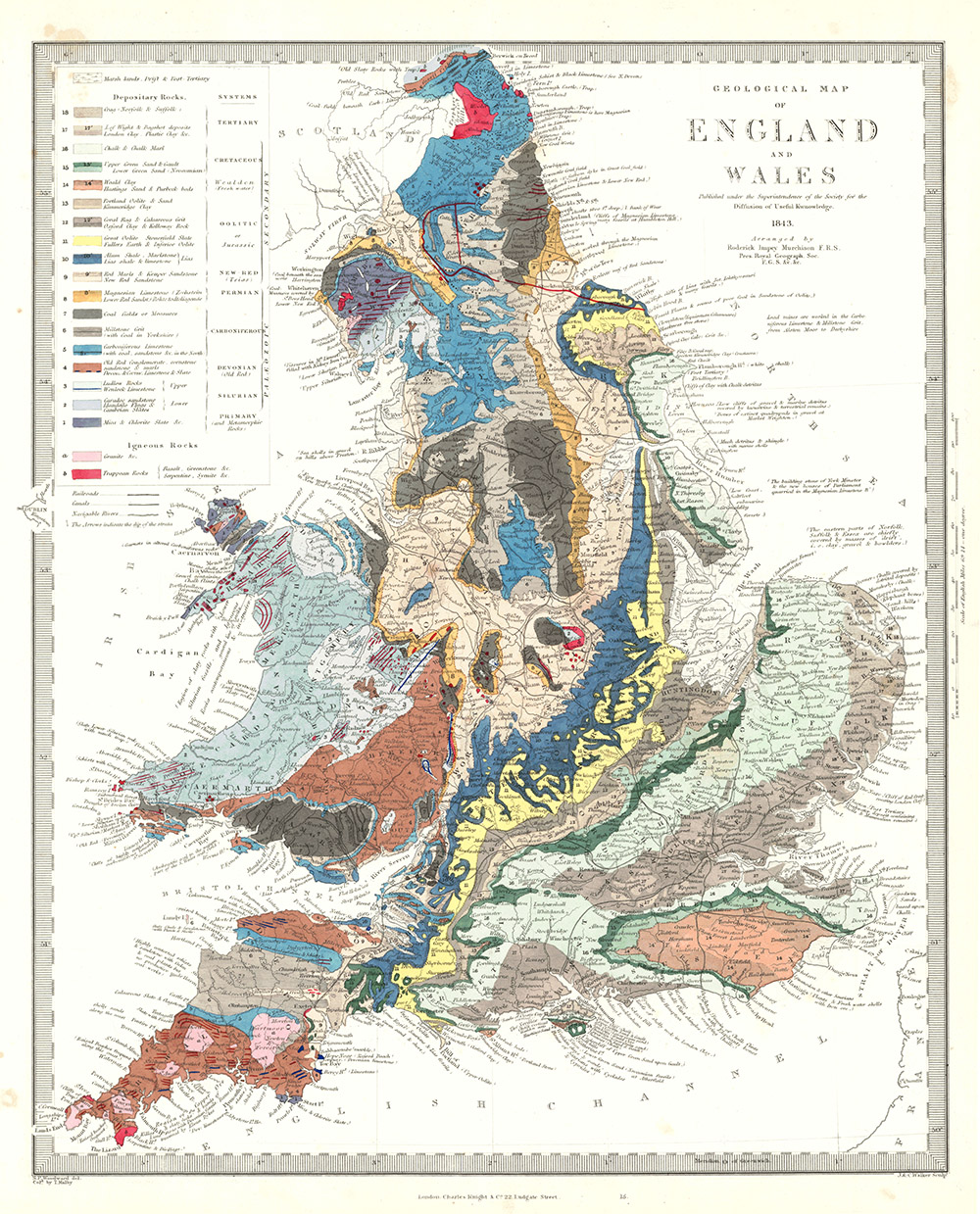
Figure 4.
The 1843 “Geological Map of England and Wales”, prepared by Roderick Murchison with assistance from Samuel P. Woodward. Adapted for nonprofit, educational purposes from an internet sale site.
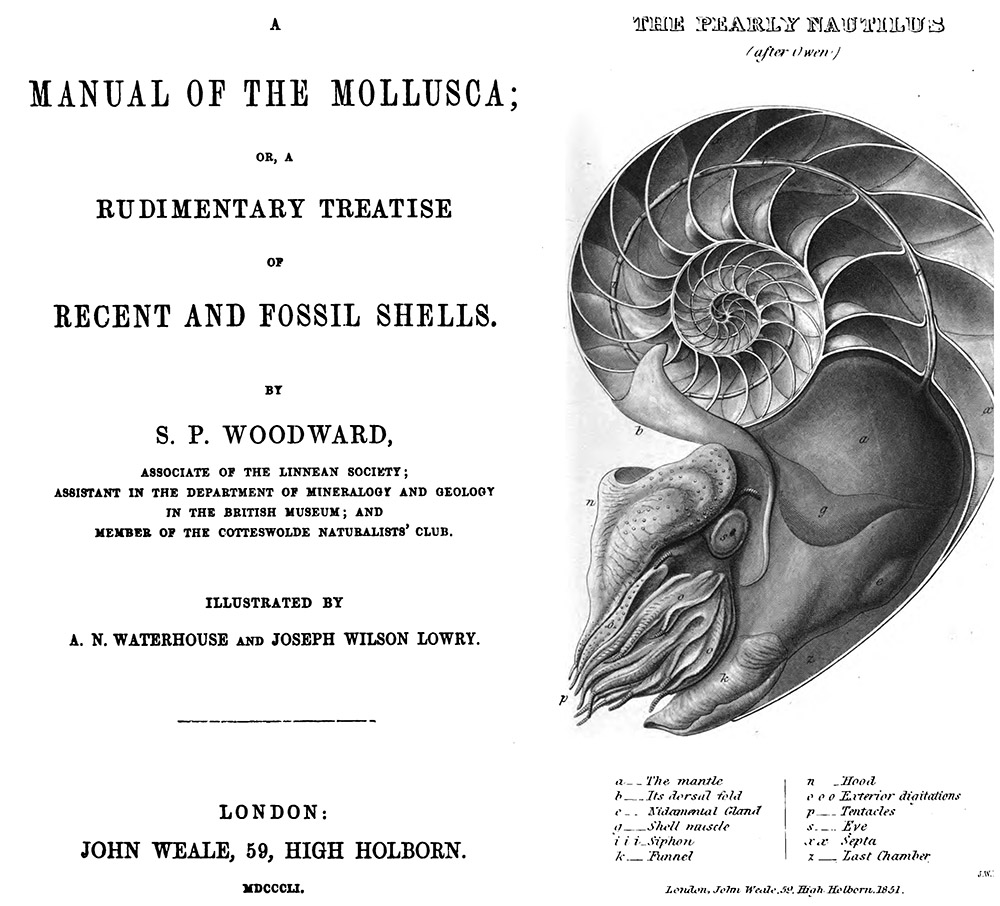
Figure 5.
Title page and frontispiece from S.P. Woodward’s 1851 “Manual of the Mollusca”, Volume 1. Two additional volumes followed, in 1853 and 1856. Despite Woodward’s skills as an illustrator, none of the images, including the frontispiece, were produced by him.
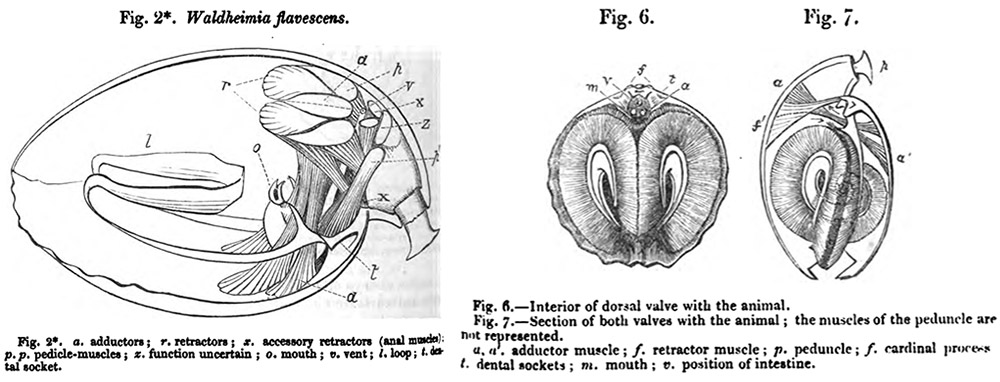
Figure 6.
Illustrations by S.P. Woodward, from John Edward Gray’s 1853 “Catalogue of the Mollusca in the Collection of the British Museum”.

Figure 7.
Illustrations produced by Samuel P. Woodward for Richard Owen’s 1861 “Palaeontology”.
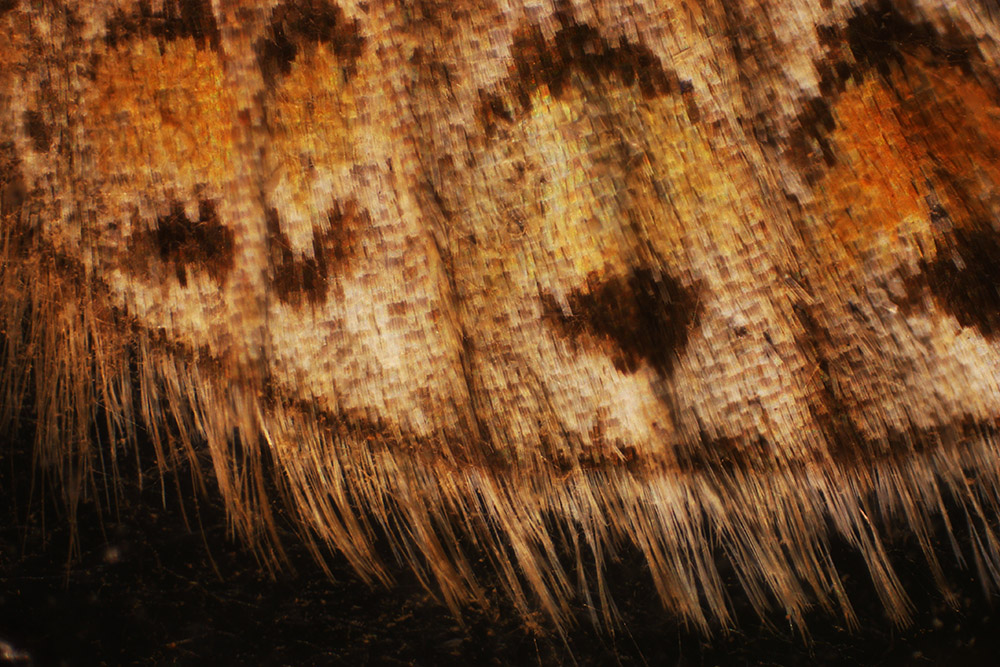
Figure 8.
Wing of a Polyommatus butterfly, prepared by Samuel Woodward in 1847 (see Figure 1). Photographed with a C-mounted digital SLR camera, a 3.5x objective lens, and lighting from above.
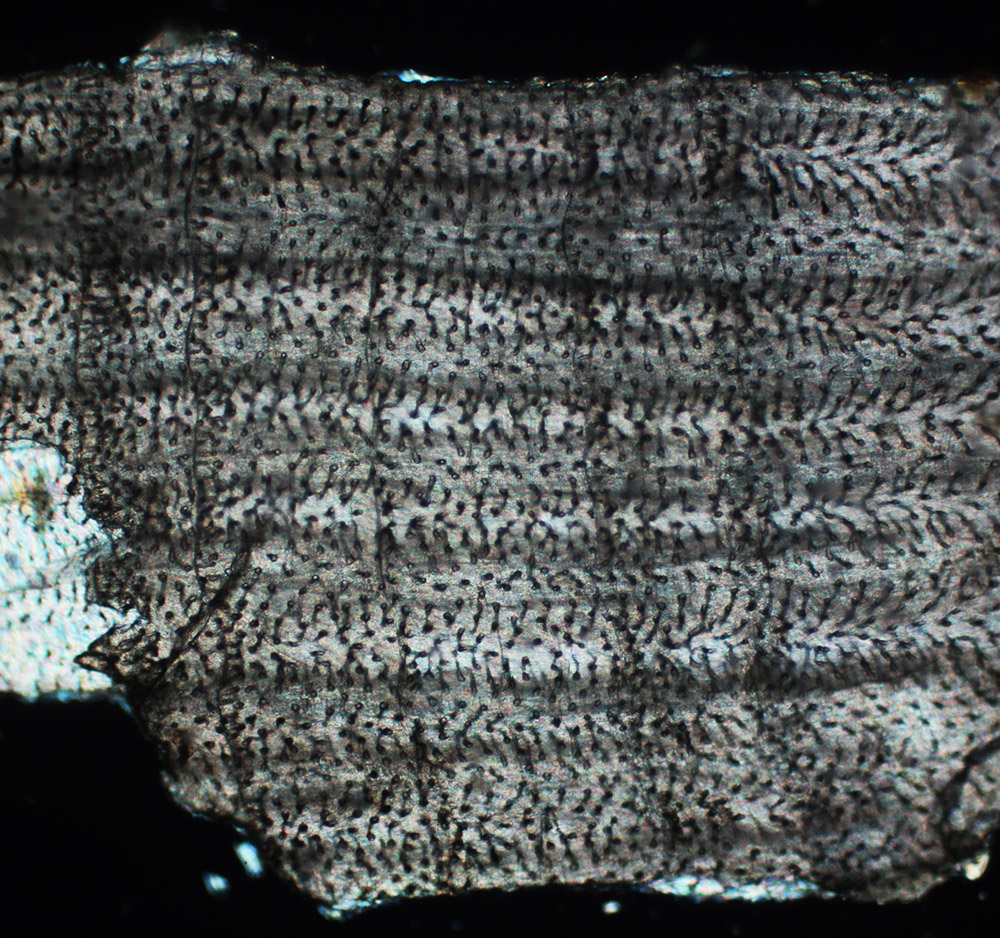
Figure 9.
A piece of shell from Terebratulina caput-serpentis, mounted by Samuel Woodward in 1861 (see Figure 1). Photographed with a C-mounted digital SLR camera, a 3.5x objective lens, and transmitted light with crossed polarizing filters.
Acknowledgement
Many thanks to Howard Lynk for identifying “S.P.W.” as Samuel P. Woodward.
Resources
Geological Magazine (1865) Obituary of Samuel P. Woodward, pages 383-384
Gray, John Edward (1853) Catalogue of the Mollusca in the Collection of the British Museum, Part 4, British Museum, London
The Natural History Review (1865) Obituary of Samuel P. Woodward, pages 579-580
Owen, Richard (1861) Palaeontology, A. & C. Black, Edinburgh
Woodward, Horace B. (1882) A memoir of Dr. S.P. Woodward, Transactions of the Norfolk and Norwich Naturalists' Society, Vol. 3, pages 279-312
Woodward, Samuel (1831) Trichiosoma lucorum, the pupa and imago of, a habitat of, and the destruction of by one of the Ichneumondae, Magazine of Natural History, pages 85-86
Woodward, Samuel P. (1851) A Manual of the Mollusca, Vol. 1, John Weale, London
Woodward, Samuel P. (1854) A Manual of the Mollusca, Vol. 2, John Weale, London
Woodward, Samuel P. (1856) A Manual of the Mollusca, Vol. 3, John Weale, London








